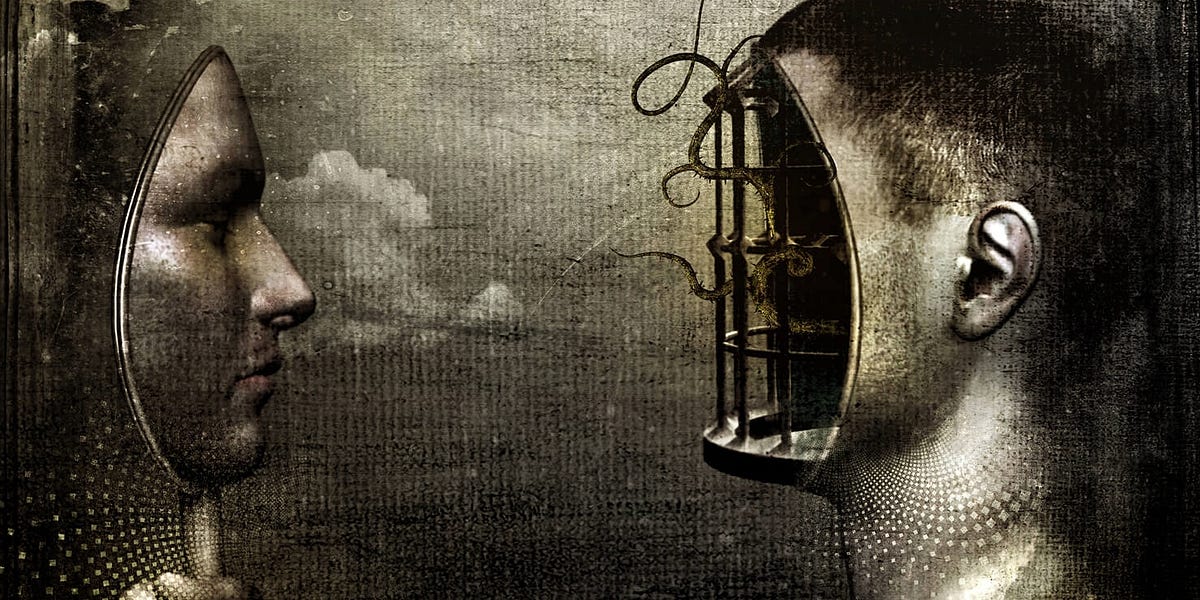Dissociation Ain't All bad

I will be honest - it's been a stressful week.
Well, being truly honest - it's been a stressful month. Or is it year?
We know stress is bad for us. While eustress (positive, healthy stress) exists, this isn't the kind of stress most of us are experiencing right now. Whether it's the political news cycle, the constant hum of invalidation and judgment emerging from our social media feeds, or simply the sense that things are moving too fast, the kind of stress we're experiencing is chronic, chaotic, and draining.
It shows up in my sleep. I've had more trouble falling asleep. I've been waking up earlier. When I lie down, there's a gnawing sense that I've forgotten something - but what?
I know that chronic stress, though it often feels like it's driving me to greater heights, exacts a heavy toll. Over time, it degrades my capacity, crushes my mood, and leads me to make poor decisions. Handling this onslaught of stress (which, unfortunately, I don't foresee going away any time soon) was thus one of my priorities for the next few months.
I'm trying a variety of things, none of which are controversial: magnesium supplementation and a more regular sleep schedule to help with sleep quality, meditation, doubling down on my gratitude practice (one of the big wins of the year already), and so on.
But there's one thing that consistently has a significant and immediate impact on the amount of stress I'm experiencing that isn't as well-known:
Dissociation.
Dissociation has a negative connotation in our culture.
That's for good reason; we've all experienced that strange, floating sensation of dissociation after spending too long scrolling on our phones, engaged in the flat world of digital images and disconnected from physical reality.
But dissociation has a long history of being used for good.
The concept of "desagregation" was first introduced by Pierre Janet in 1889. Translated into English as "dissociation," it appeared in William James' monumental Principles of Psychology. While it was mostly considered an automatic function, Ernest Hilgard (Stanford professor, president of the American Psychological Association and extremely influential hypnosis researcher) pointed to dissociation as the basic mechanism of all hypnotic experience - meaning it could not just be deliberately induced, but sat at the center of healing clinical experience.
Janet defined hypnosis as “A process whereby a group of psychological activities processing a certain unity among themselves lose most of their relationship with the rest of the personality and function more or less independently.” This concept of separation of processes which typically act as a whole remains central to most definitions of dissociation today. Michael Yapko, clinical psychologist and author of perhaps the best introductory hypnosis textbook, defined dissociation as “the ability to break a global experience into its component parts, setting the stage to amplify awareness for one part while diminishing awareness for the others.”
Yapko's move to define dissociation as an ability rather than a passive, automatic process is indicative of the way in which views of dissociation have changed over recent years. Psychology has moved away from Freud's initial conception of many psychological processes as fundamentally hidden within the unconscious (repression being the primary example) towards a view in which many psychological processes can be deliberately triggered or controlled (or, at the very least, guided).
I'm not sure how I feel about that tendency generally (I have an aesthetic affinity for the Lacanians, who resist our (primarily American) tendency to believe we can control and "use" the unconscious mind), but both hypnotherapeutic practice and simple self-experimentation have shown me that dissociation, at the very least, is relatively easy to bring about.
Why is this important? Because the vast majority of our emotional problems (of which "stress" is simply one example) primarily stem from identification, and dissociation is our built-in way of tearing identification down.
Identity has a positive connotation in our culture.
We all want to know our "identity." We seek to identify with the different groups that represent us. Both parties engage relentlessly in identity politics. We wave flags, join groups, and wear clothing with prominent designer labels. We all want to both know and project our identity.
But identity is not just something we do - it's baked into our language. This was the message of Alfred Korzybski, the thinker behind General Semantics. Korzybski believed that the English language, so dependent on the verb "to be," fundamentally misled us into thinking the universe was a static place where things "were" a certain way. This, Korzybski argued, is an illusion: the universe experiences constant flux, and trying to pin it down by saying it "is" something in particular leads only to error.
Whether or not you buy into Korzybski's philosophy, he's not the only one who has pointed to identity as a significant source of suffering. Schools of thought from Buddhism to Internal Family Systems to Cognitive Behavioral Therapy have noted that mental suffering emerges from identifying with our mental state; in essence, we experience ourselves as "being" (there's Korzybski again) sad, or stressed, or upset, rather than experiencing those things.
This blending of identity with our mental or emotional state causes real pain. Think back to the last time you were lost in the throes of a particularly negative emotional storm. How did it feel? You were experiencing symptoms similar to those of a physical injury - a pained look on your face, knot in your stomach, pulse pounding, blood pressure rising, tears. In other words, physical anguish.
Believe you are something strongly enough, and your mind will oblige you by making it true. Therefore:
If you believe you are in pain, you will be.
But there is an escape here.
Recall our previous definitions of dissociation:
"A process whereby...psychological activities processing a certain unity among themselves lose most of their relationship with the rest of the personality..."
“The ability to break a global experience into its component parts, setting the stage to amplify awareness for one part while diminishing awareness for the others...”
If identification with our emotional states causes pain, then we should expect dissociation to reduce it.
This is, in fact, what we see in practice.
In the broadest sense, dissociation is merely separation - when we experience ourselves as separated from what is happening, we are experiencing dissociation.
In this context, we see dissociation at work in nearly every intervention designed to reduce emotional suffering.
Take, as an example, The Work by Byron Katie, a popular self-help technique.
The Work revolves around four questions to ask yourself when you are experiencing emotional suffering. Those questions are:
Is it true?
Can you absolutely know that it’s true?
How do you react when you believe that thought?
Who would you be without the thought?
While the questions focus on the truth of a given statement, note what is necessary in order to even begin answering them: dissociation.
In order for us to question and analyze an emotional state, that emotional state must exist as an entity separate from us. We must separate from the thing we wish to analyze in order to see it clearly. In this way, delineating a belief so that it may be analyzed automatically creates dissociation from the troubling thought. This process continues with the question of How do you react when you believe that thought?, since the "you" doing the analysis is now dissociated from the "you" who reacts to the thought. There are now multiple layers of distance between you and the emotional experience - and subsequently, significantly less emotional and physical activation.
Eckhart Tolle, author of the best-selling book The Power of Now, recommended a practice heavily rooted in dissociation. Tolle argued that simply "becoming aware" of emotions as they arise wasn't enough; if we become more aware of our emotional states while also identifying with them, we increase the amount of suffering we experience.
Instead, Tolle wanted us to become aware of our emotions as they arise and then label them in a very particular way. Rather than thinking "I am sad" or "I am stressed," Tolle wanted us to think "Having a thought about sadness" or "having a thought about stress."
Note what this is doing: removing the verb "to be." In fact, Tolle's suggested linguistic structure is nearly identical to the ones that Korzybski and his followers recommended (going so far as to create a new version of English, E-Prime, with no verb for "to be"). This automatically induces a level of dissociation: after all, you are not sad, but rather having a thought about sadness.
There is an immediate shift in physical state when using this technique. I recommend that you try it yourself to see what I mean.
In cognitive behavioral therapy, we give our emotional patterns funny names to create a sense of dissociation - "Oh, there's that old pattern again, Stressed Sammy." In Internal Family Systems (or any of the "parts"-based therapies that emerged from Gestalt Therapy), we visualize an emotional pattern as a separate being and have a conversation with it. The list goes on and on, with the unifying theme becoming increasingly obvious: dissociation from an emotional state helps us to reduce suffering and see the world more clearly.
The world can be a stressful place. You are not maladapted if you're feeling that in your gut lately: we are living in uncertain times.
But stress is only useful as an early-warning sign. It's there to alert us to potential dangers, to make sure our attention is focused on preventing catastrophe. Once we've done this, repeated and chronic stress does not make us safer nor lead us to better decision-making; instead, it does the opposite, wearing us down over time and diminishing our capacity to act.
But we have a tool in our toolbox to handle exactly this: dissociation. Getting distance from an emotional state or story can help us to see it more clearly, reduce the suffering we experience, and escape our solipsistic egos. All we need to do is remind ourselves that we are not our thoughts; that can be as simple as labeling our thoughts as such.
And so: I am no longer stressed out.
I've just been having some thoughts about stress.
And that's made all the difference.
Yours,
Dan
COOL STUFF I'M READING:
A very helpful little meditation on authenticity, and why it matters.

Better Questions Newsletter
Join the newsletter to receive the latest updates in your inbox.

